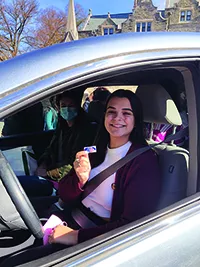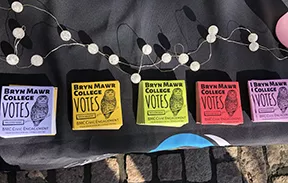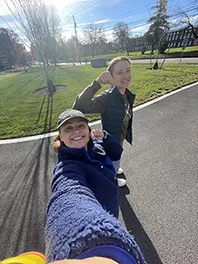I Voted!
Getting out the vote is a campus priority during election season. So is educating students about the democratic process.
Helen Christ ’24 remembers how excited she was the first time she got to cast her vote in person in November 2020. Having voted by mail in the spring primaries, thanks to the pandemic, that fall, “My friends and I walked over to the polling place on Montgomery Avenue and then went to Dunkin’ Donuts afterwards as a reward. It was really fun!”
For the hotly contested midterm elections this past November, Christ signed up to drive the College’s campus van shuttle to and from the pollls. “I thought it was such a great idea that Bryn Mawr was providing a shuttle,” she says.
“I was excited to volunteer to help remove any possible obstacles to students being able to cast a vote.” — Helen Christ '24
The College gave rides to 222 students on Election Day 2022, with a van (driven by student, faculty, and staff volunteers) running a continuous loop between Goodhart Hall and the Bryn Mawr Presbyterian Church polling station from 9 a.m. to 8 p.m.
“Colleges are a prime space for getting students off on the right foot when it comes to participation in elections,” says Director of Civic Engagement Ellie Esmond. “It’s an exciting part of a student’s experience as a young adult to vote for the first time and to figure out what issues are important to them.”
Esmond refutes the common perception that young- adults are apathetic when it comes to politics and civic engagement. “I’ve never found that to be true,” she says. “I’ve always found that students are very geared up to vote, very willing to do their research, and really excited about participating.”
Her biggest priority, she says, is to make sure they understand the options available to them. Many don’t realize that they can vote either in their home state or at school. “We have no skin in the game,” says Esmond. “We just want students to engage where they feel the most connected to the election and the community and the issues.”
Esmond and her team organize campus voter registration drives and provide information to help students register in Pennsylvania. They also meet with students individually to help them make sure their registration in their home state is up to date. “Some students do look at how their state usually goes—if it goes red or if it goes blue—and they make their decision based on that,” she says.
Registration is just the first step. Many schools have high voter registration rates, but their turnout rate is less impressive, Esmond says. “So, part of the civic education is, OK, you’ve done part one, but you have to do part two or part one doesn’t even matter.”
Educating students on how to vote by mail is part of the puzzle, too, for students who have a busy schedule on Election Day, are athletes, or are involved in a lot of extracurriculars or co-curriculars.
Though Esmond’s office never endorses a candidate or suggests that students register for any particular party, they work to educate students on how to research the issues and the candidates and engage with the topics. Sometimes that involves bringing people from nonpartisan organizations like the League of Women Voters to campus for panel discussions and information sessions. “That way, students can walk into the polling booth feeling very prepared.”
Campus student groups play an active role, too. “If we have one focus, it’s just to get students registered to vote,” says Amanda Blatz ’23, who leads the Bryn Mawr College Democrats club.
As well as organizing tabling events, Blatz and her fellow members make posters and host debate watch parties. Just before the midterms, they invited Representative Mary Gay Scanlon to visit campus to talk about issues on the ballot, why she was running, and what her life in politics looks like.
For faculty, elections offer teaching opportunities on many levels. Marissa Golden, a political science professor, talks to her students about the history of voting rights and emphasizes that this is a right that not everyone had until relatively recently in the U.S. She also gives them statistics about close elections where small numbers of voters have made a difference.
Recognizing the extra hoops students who want to stay registered in their hometown must go through, Golden even provides stamps for them to return their mail-in ballots.
“Political science research pretty consistently shows the lower the barriers to voting, the higher the turnout,” says Golden, “and those barriers can be as simple as a 10-minute walk, a rainy day—or needing a stamp.”
Running the van shuttle is just one more way to make students feel supported, says Esmond, who typically spends most of the day with colleagues at a table set up outside Goodhart, answering last-minute questions and helping students double check that their voter registration went through.
The College’s designated polling place is close, less than half a mile, but many students take the van, Esmond says, because it’s fun to vote with their friends and have a ride. “A lot of people walk back once they see how close it is,” she says, “but if someone’s in a hurry, it’s nice to give them a quick ride over.”
People sometimes ask why the College doesn’t have its own polling place on campus, says Esmond. “And I’ve always said it’s because ours is so convenient,” she says. “There are never lines and students move through quickly. Also, it’s neat to see other voters. I just always think it’s good to get off campus and see how things work elsewhere.”
For Blatz, who led the voter registration drive at her high school in Ohio and has worked on voter outreach for local campaigns, encouraging young people to vote is about empowerment.
“So many people believe they are powerless and don’t have ability to promote change. But the past few elections have highlighted that every vote matters and every vote is a way to change the world that we live in.” — Amanda Blatz '23
Published on: 02/20/2023


